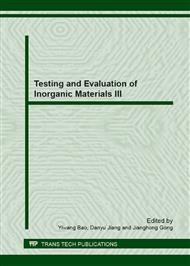[1]
R. Tenne, L. Margulis, M. Genut, G. Hodes, Polyhedral and cylindrical structures of WS2, Nature 360 (1992) 444-445.
DOI: 10.1038/360444a0
Google Scholar
[2]
Y. Feldman, E. Wasserman, D.J. Srolovitz, R. Tenne, Nested inorganic fullerenes and nanotubes, Science 267 (1995) 222-225.
DOI: 10.1126/science.267.5195.222
Google Scholar
[3]
L. Rapoport, V. Leshchinsky, I. Lapsker, Yu. Volovik, O. Nepomnyashchy, M. Lvovsky, R. Popovitz-Biro, Y. Feldman, R. Tenne, Tribological properties of WS2 nanoparticles under mixed lubrication, Wear 255 (2003) 785-793.
DOI: 10.1016/s0043-1648(03)00044-9
Google Scholar
[4]
L. Rapoport,a N. Fleischerb, R. Tenne, Applications of WS2 (MoS2) inorganic nanotubes and fullerene-like nanoparticles for solid lubrication and for structural nanocomposites, J. Mater. Chem. 15 (2005) 1782-1788.
DOI: 10.1039/b417488g
Google Scholar
[5]
Y.Q. Zhu, T. Sekine, K.S. Brigatti, S. Firth, R. Tenne, R. Rosentsveig, H.W. Kroto, D.R.M. Walton, Shock-wave resistance of WS2 nanotubes, J. Am. Chem. Soc. 125 (2003) 1329-1333.
DOI: 10.1021/ja021208i
Google Scholar
[6]
Y.Q. Zhu, T. Sekine, Y.H. Li, M.W. Fay, Y.M. Zhao, C.H.P. Poa, W.X. Wang, M.J. Roe, P.D. Brown, N. Fleischer, R. Tenne, Shock-absorbing and failure mechanisms of WS2 and MoS2 nanoparticles with fullerene-like structures under shock wave pressure, J. Am. Chem. Soc. 127 (2005) 16263-16272.
DOI: 10.1021/ja054715j
Google Scholar
[7]
Y. Feldman, A. Zak, R. Popovitz-Biro, R. Tenne, New reactor for production of tungsten disulfide hollow onion-like (inorganic fullerene-like) nanoparticles, Solid State Sci. 2 (2000) 663-672.
DOI: 10.1016/s1293-2558(00)01070-0
Google Scholar
[8]
I. Wiesel, H. Arbel, A. Albu-Yaron, R. Popovitz-Biro, J.M. Gordon, D. Feuermann, R. Tenne, Synthesis of WS2 and MoS2 fullerene-like nanoparticles from solid precursors, Nano Res. 2 (2009) 416-424.
DOI: 10.1007/s12274-009-9034-7
Google Scholar
[9]
Y.Q. Zhu, W.K. Hsu, N. Grobert, B.H. Chang, M. Terrones, H. Terrones, H.W. Kroto, D.R.M. Walton, Production of WS2 Nanotubes, Chem. Mater. 12 (2000) 1190-1194.
DOI: 10.1021/cm991189k
Google Scholar
[10]
Y.Q. Zhu, T. Sekine, Y.H. Li, W.X. Wang, M.W. Fay, H. Edwards, P.D. Brown, N. Fleischer, R. Tenne, WS2 and MoS2 inorganic fullerences-super shock absorbers at very high pressures, Adv. Mater. 17 (2005) 1500-1503.
DOI: 10.1002/adma.200401962
Google Scholar


